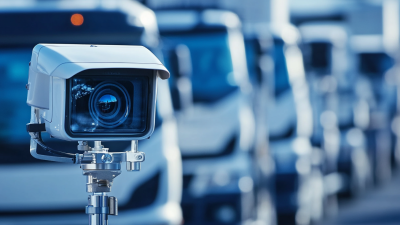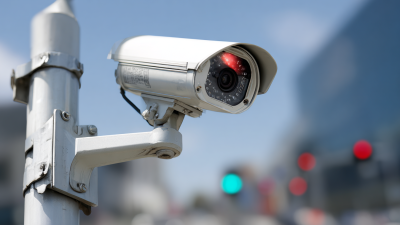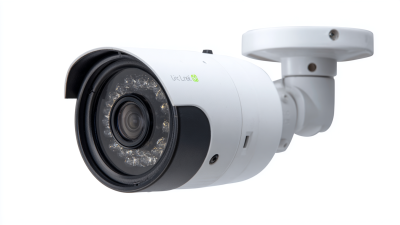In today's fast-paced transportation industry, the integration of advanced technologies is pivotal for ensuring both driver safety and the efficiency of fleet management. One of the most transformative innovations in this sector is the use of Fleet Cameras. These sophisticated devices are designed not only to monitor driving behaviors but also to provide real-time insights into fleet operations. By capturing critical data on road conditions, driver actions, and vehicle performance, Fleet Cameras play a crucial role in enhancing safety protocols and reducing accident rates.

Moreover, the footage and analytics generated by these cameras empower fleet managers to make informed decisions, streamline operations, and implement effective training programs. As companies prioritize safety and efficiency, the adoption of Fleet Cameras becomes paramount in navigating the complexities of modern fleet management.
Fleet cameras play a crucial role in enhancing driver accountability through real-time monitoring. By providing an always-on view of driver behavior, these cameras allow fleet managers to track not only the adherence to safety protocols but also the overall conduct of drivers on the road. This immediate feedback can lead to quicker interventions in risky behaviors, whether it's speeding, harsh braking, or distracted driving. Drivers are aware that their actions are being recorded, which often promotes a culture of safety and responsibility within the fleet.
Moreover, real-time monitoring facilitates timely and accurate reporting of incidents. In case of accidents, fleet cameras can provide valuable evidence that can be critical for resolving disputes and improving safety protocols. This transparency not only protects the company from potential liabilities but also fosters trust among drivers, knowing that the systems in place are designed to support rather than penalize them. Ultimately, integrating fleet cameras into daily operations enhances driver accountability while contributing to a safer and more efficient fleet management environment.
Fleet cameras, especially those equipped with AI technology, are proving to be game-changers for enhancing driver safety and improving fleet management efficiency. Recent studies indicate that fleets utilizing AI-enabled dash cameras can reduce crash rates by nearly 75% over 30 months. Unlike standard cameras, these advanced systems not only monitor drivers but also provide real-time coaching, significantly reducing preventable accidents. This data-driven approach to safety helps fleets identify risky behaviors and take proactive measures to mitigate them.
Tips for maximizing the benefits of fleet cameras include implementing regular training sessions for drivers, which can reinforce safe driving practices learned through camera feedback. Additionally, integrating weather intelligence features can provide critical insights during adverse conditions, further enhancing safety measures. It's also advisable to analyze video footage to refine driving policies based on tangible data, ultimately leading to a safer driving culture and reduced operational risks for the fleet.
With the rising pressure to control costs amidst increasingly dangerous driving behaviors, investing in technology like fleet cameras becomes essential. Companies that adopt comprehensive safety systems can expect not only reductions in accident rates but also significant cuts in insurance costs, making them well-positioned for the future of fleet management.
| Metric | Before Implementation | After Implementation | Percentage Improvement |
|---|---|---|---|
| Accident Rate (incidents per 100,000 miles) | 4.5 | 2.2 | 51.11% |
| Driver Behavior Score (out of 100) | 75 | 85 | 13.33% |
| Fuel Efficiency (miles per gallon) | 8.0 | 9.2 | 15.00% |
| Insurance Cost ($ per year) | 15000 | 12000 | 20.00% |
| Maintenance Costs ($ per vehicle per year) | 3000 | 2500 | 16.67% |
 Fleet camera analytics and reporting tools are revolutionizing the way companies manage their fleet operations. According to a report by the American Transportation Research Institute, fleet-related incidents account for a significant loss in operational efficiency, costing the industry over $72 billion annually. By integrating advanced camera systems, fleets can access real-time data and generate actionable insights that enhance decision-making processes.
Fleet camera analytics and reporting tools are revolutionizing the way companies manage their fleet operations. According to a report by the American Transportation Research Institute, fleet-related incidents account for a significant loss in operational efficiency, costing the industry over $72 billion annually. By integrating advanced camera systems, fleets can access real-time data and generate actionable insights that enhance decision-making processes.
One of the key advantages of fleet cameras is their ability to provide comprehensive video footage that can be analyzed to identify patterns in driver behavior and fleet performance. With tools that track metrics such as speed, braking patterns, and route efficiency, fleet managers can implement targeted training programs for drivers, ultimately leading to a reduction in risky driving behaviors. A study by the National Highway Traffic Safety Administration has shown that fleets using camera technology have seen a 20% reduction in accident rates.
Tips: Regularly review footage and analytics to identify trends and areas for improvement. Encourage drivers to adopt safer practices by sharing insights from the camera data. Additionally, investing in predictive analytics can help prevent potential issues before they arise, saving both time and resources.
The integration of fleet cameras with telemetry systems creates a comprehensive solution for enhancing driver safety and improving fleet management efficiency. By combining visual data from cameras with real-time telemetry metrics, fleet managers can gain a more detailed understanding of driver behavior and vehicle performance. This holistic approach allows for proactive measures to be taken, ultimately leading to safer driving environments and more efficient operations.

Tips for effective integration include ensuring that cameras are strategically placed to capture critical views without distracting drivers. Regularly reviewing footage and analytics can help identify patterns in unsafe driving or vehicle misuse, allowing for targeted training sessions. Additionally, using telemetry data alongside camera footage can provide insights into vehicle health, enabling timely maintenance and reducing the risk of breakdowns on the road.
Adopting a data-driven mindset is essential. Fleet managers should invest in training staff to interpret the data gathered from cameras and telemetry. This can enhance compliance with safety regulations and promote accountability among drivers. By leveraging technology in this way, fleets can achieve not only higher safety standards but also optimize their operational efficiency.
Implementing fleet camera systems can significantly enhance safety while simultaneously improving management efficiency. The initial investment in these technologies may seem daunting, but a comprehensive cost-benefit analysis reveals compelling long-term savings.
Fleet cameras offer real-time monitoring capabilities, allowing for immediate response to incidents and better prevention of accidents. This proactive approach not only minimizes potential legal costs from accidents but also aids in lowering insurance premiums over time.
Moreover, the data gathered from fleet cameras provides invaluable insights into driver behavior and vehicle performance. Analyzing this information helps identify patterns that can lead to more effective training programs, reducing instances of reckless driving and improving overall road safety. Consequently, fleets can experience
decreased operational costs through a decline in accidents and related expenses. The proactive measures facilitated by fleet camera systems contribute not only to the safety of drivers and vehicles but also result in substantial savings that justify the initial investment in these advanced technologies.





